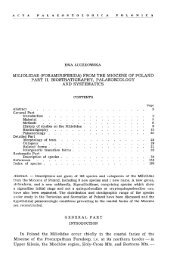Full text - Acta Palaeontologica Polonica
Full text - Acta Palaeontologica Polonica
Full text - Acta Palaeontologica Polonica
Create successful ePaper yourself
Turn your PDF publications into a flip-book with our unique Google optimized e-Paper software.
CAZE ET AL.—COLOUR PATTERNS IN AMPULLINIDAE 331<br />
axial zonation of<br />
the background<br />
residual colour<br />
spiral<br />
"stripe"<br />
spiral<br />
stripe<br />
axial<br />
stripe<br />
axial segment<br />
spiral<br />
"stripe"<br />
axial segment<br />
axial<br />
stripe<br />
patches<br />
Stripes (Fig. 1B, C): this term applies to any elongated fluo−<br />
rescent colour pattern component which is axially or spirally<br />
continuous on the whole shell.<br />
“Stripes” (Fig. 1D, E): the use of quotes illustrates the desire<br />
to distinguish the result of a lack of fluorescence from well<br />
delineated fluorescent stripes.<br />
Patches (Fig. 1F): this term applies to any small area of a col−<br />
our contrasting sharply with the background.<br />
Segments (Fig. 1G): the segments are short elongated sec−<br />
tions, generally resulting from the coalescence of patches.<br />
They are always axially elongated in ampullinids.<br />
A survey of colour patterns<br />
according to systematic order<br />
Clade Sorbeoconcha Ponder and Lindberg, 1997<br />
Superfamily Campaniloidea Douvillé, 1904<br />
Family Ampullinidae Cossmann, 1919<br />
Genus Ampullina Bowdich, 1822<br />
Type species: Ampullaria depressa Lamarck, 1804, Grignon, Lutetian.<br />
Description.—Worldwide, this genus consists of 42 species<br />
in the Cainozoic, of which 41 occur in the Palaeogene (SOM<br />
1). 14 of the 34 species observed under UV light reveal a sim−<br />
ple and unsophisticated residual colour pattern consisting of<br />
fluorescent straight spiral stripes or a diffuse area (SOM 2).<br />
However, on the basis of shell morphology, we include in<br />
this genus three species previously attributed to Crommium,<br />
Ampullina intermedia (Deshayes, 1832), Ampullina ligni−<br />
tara (Deshayes, 1864), and Ampullina merciniensis (Desha−<br />
yes, 1864). They display fluorescent patches or segments,<br />
sometimes superimposed on broad spiral stripes.<br />
Ampullina depressa depressa (Lamarck, 1804)<br />
Fig. 2A.<br />
Stratigraphic and geographic range.—Middle Eocene, Lute−<br />
tian–Bartonian (PB, Loire−Atlantique).<br />
Fig. 1. Descriptive terminology of the residual colour patterns of the Ampul−<br />
linidae. A. Crommium acutum (d’Orbigny, 1850), MNHN B58618 (MNHN<br />
coll.), Parnes, Oise, France, Lutetian, in ventral view. B. Globularia (Cer−<br />
nina) fluctuata (Sowerby, 1825), MNHN IM (Staadt coll.), Banggi Island,<br />
Kudat division of Sabah, Malaysia, Recent, in dorsal view. C. Ampullina<br />
parisiensis (d’Orbigny, 1850), MNHN A30403 (MNHN coll.), Villiers−<br />
Saint−Frédéric, Yvelines, France, Lutetian, in dorsal view. D. Globularia<br />
(Deshayesia) parisiensis (Raulin, 1844), MNHN A30892 (Cossmann coll.),<br />
Morigny (Château de Brunehaut), Essonne, France, Rupelian (Stampian), in<br />
dorsal view. E. Ampullina rustica (Deshayes, 1864), MNHN A30414 (Ledon<br />
coll.), Douains, Eure, France, Lutetian, in apical view. F. Ampullina inter−<br />
media (Deshayes, 1832), MNHN A30416 (MNHN coll.), Cuise−la−Motte,<br />
Oise, France, Ypresian (Cuisian), in dorsal view. G. Ampullina intermedia<br />
(Deshayes, 1832), MNHN A30417 (MNHN coll.), Cuise−Lamotte, in labral<br />
view. Scale bars 10 mm. Photographs by C. Lemzaouda and P. Loubry<br />
(MNHN).<br />
doi:10.4202/app.2009.0084
















